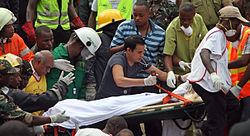2013 Dar es Salaam building collapse
[5][6] The building was owned by Raza Huseein Damji[7][8] with the National Housing Corporation (NHC) having a 25 percent share in the project.
[10] The project inspector ensured protocol was followed but when the ten floors were completed the oversight responsibility changed to a different governmental body.
[14] The Tanzanian Red Cross expressed relief that the casualty figures could have been far higher but the streets were relatively empty of vendors and shoppers due to the holiday.
[16] A week after the collapse, on 5 April, The Minister for Lands, Housing and Human Settlements Development, Prof Anna Tibaijuka issued an order for the owner to demolish the second 16-storey building, based on information gathered by government officials that it was ill-constructed as well.
[22] Weeks after the incident, in the parliament budget speech, Prof Kulikoyela Kahigi said that the government should bear the blame, considering the fact that former Prime Minister Edward Lowassa formed a task force in 2006 to investigate the state of buildings under construction but its recommendations were ignored.
[24] Other victims include Kulwa khalfan, Hamada Mussa, Kessy Ally Manjapa, Hamis Zuberi Mkomwa, Boniface Bernard, Seleman Haji, Seleman Mtego, Sikudhani Mohamed, Ahmed Salum Mirambo, Salum Issa Mapunda, Selemani Rashid Mnyani, John Mtyani Majewa, Mussa Ally Munyamani, David Severin Helman, William Joackim, Abdulhaman Othman Mwiha, Emmanuel Christian, Mmanyi Jumanne Ngadula, Advai Mpinge Desiki, Emmanuel Grayson Wahai and Augustino Kanisius Chuma.
The conditions of the bail required each of the accused to secure two reliable guarantors, who would have to sign a bond of TSh 20 million (~US$12,300)[30] each and bring along formal letters of introduction from their local governments.


